
|
You entered: Orion
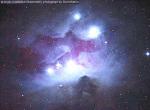 NGC 1977: Blue Reflection Nebula in Orion
NGC 1977: Blue Reflection Nebula in Orion
22.07.2001
The Orion Nebula is visible to the unaided eye as a fuzzy patch near the famous belt of three stars in the Orion. The above picture captures a part of the Orion Nebula that primarily reflects light from bright Orion stars.
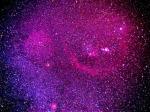 Orion: The Big Picture
Orion: The Big Picture
1.12.1997
Orion is big. Some of the stars that form the constellation of Orion are part of a giant gas cloud complex that stretches over 100 light years and appears more than 50 times the diameter of the Moon.
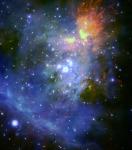 The Orion Nebula from Subaru
The Orion Nebula from Subaru
2.02.1999
The Orion Nebula (M42) shows a host of treasures when viewed in infrared light. Some stars in the Trapezium, an open cluster of stars at the center, are only visible in infrared light. The orange feature above center is called the Kleinman-Low Nebula, and appears greatly affected by newly forming central star IRc2.
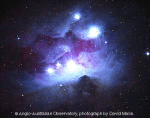 NGC 1977: Blue Reflection Nebula in Orion
NGC 1977: Blue Reflection Nebula in Orion
1.02.1998
The Orion Nebula is visible to the unaided eye as a fuzzy patch near the famous belt of three stars in the constellation Orion. The above picture captures a part of the Orion Nebula that primarily reflects light from bright Orion stars.
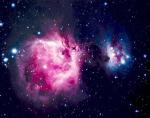 The Great Nebula in Orion
The Great Nebula in Orion
27.01.1998
The Great Nebula in Orion can be found just below and to the left of the easily identifiable belt of three stars in the popular constellation Orion. This fuzzy patch contains one of the closest stellar nurseries, lying at a distance of about 1500 light years.
 Hale-Bopp and Orion
Hale-Bopp and Orion
29.04.1997
Comet Hale-Bopp is still brighter than most constellations. In fact, Comet Hale-Bopp may now hold the record for staying bright the longest. Last week the comet was photographed above in the same field...
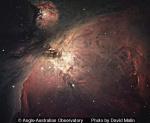 Water From Orion
Water From Orion
21.04.1998
Is Orion all wet? Recent observations have confirmed that water molecules now exist in the famous Orion Nebula, and are still forming. The Orion Nebula (M42, shown above) is known to be composed mostly of hydrogen gas, with all other atoms and molecules being comparatively rare.
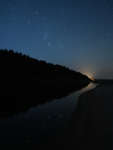 Orion Rising
Orion Rising
22.11.2019
Looking toward the east in the early hours of a September morning this single exposure made with tripod and camera captured a simple visual experience. Rising above the tree-lined slope are familiar stars in planet Earth's northern night and the constellation Orion the Hunter.
 NGC 1977: Blue Reflection Nebula in Orion
NGC 1977: Blue Reflection Nebula in Orion
20.03.1996
The Orion Nebula is visible to the unaided eye as a fuzzy patch near the famous belt of three stars in the constellation Orion. The above picture captures a part of the Orion Nebula that primarily reflects light from bright Orion stars.
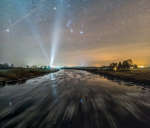 A Cold River to Orion
A Cold River to Orion
30.11.2018
Ice is forming on the river Lielupe as it flows through the landscape in this winter's night scene. Even in motion the frigid water still reflects a starry sky, though. The well planned, Orion-centered panorama looks toward the south, taken in three exposures from a bridge near the village of Stalgene, Latvia, planet Earth.
|
January February March |
||||||||||||||||||||||||||||||||||||||||||||||||||||||||